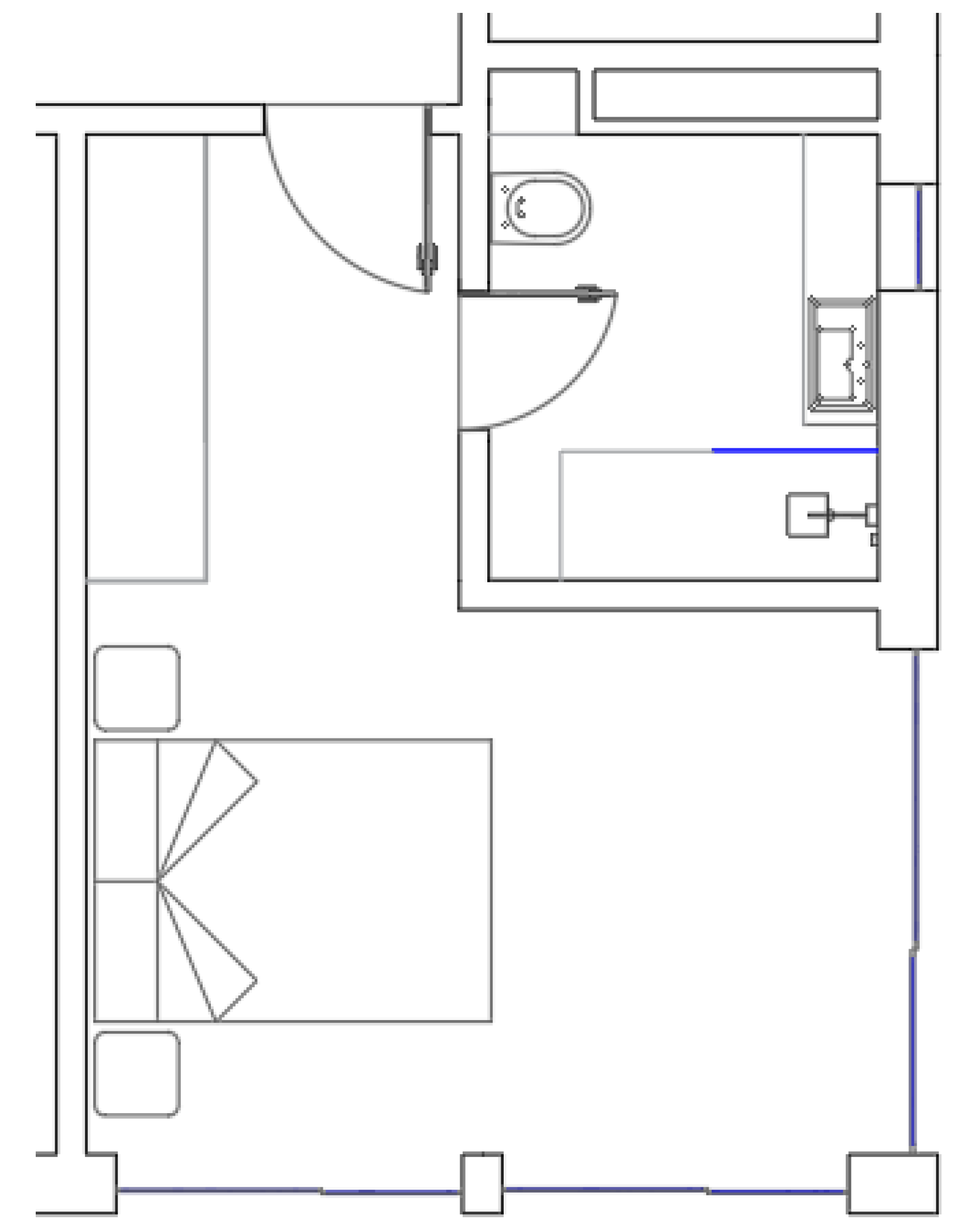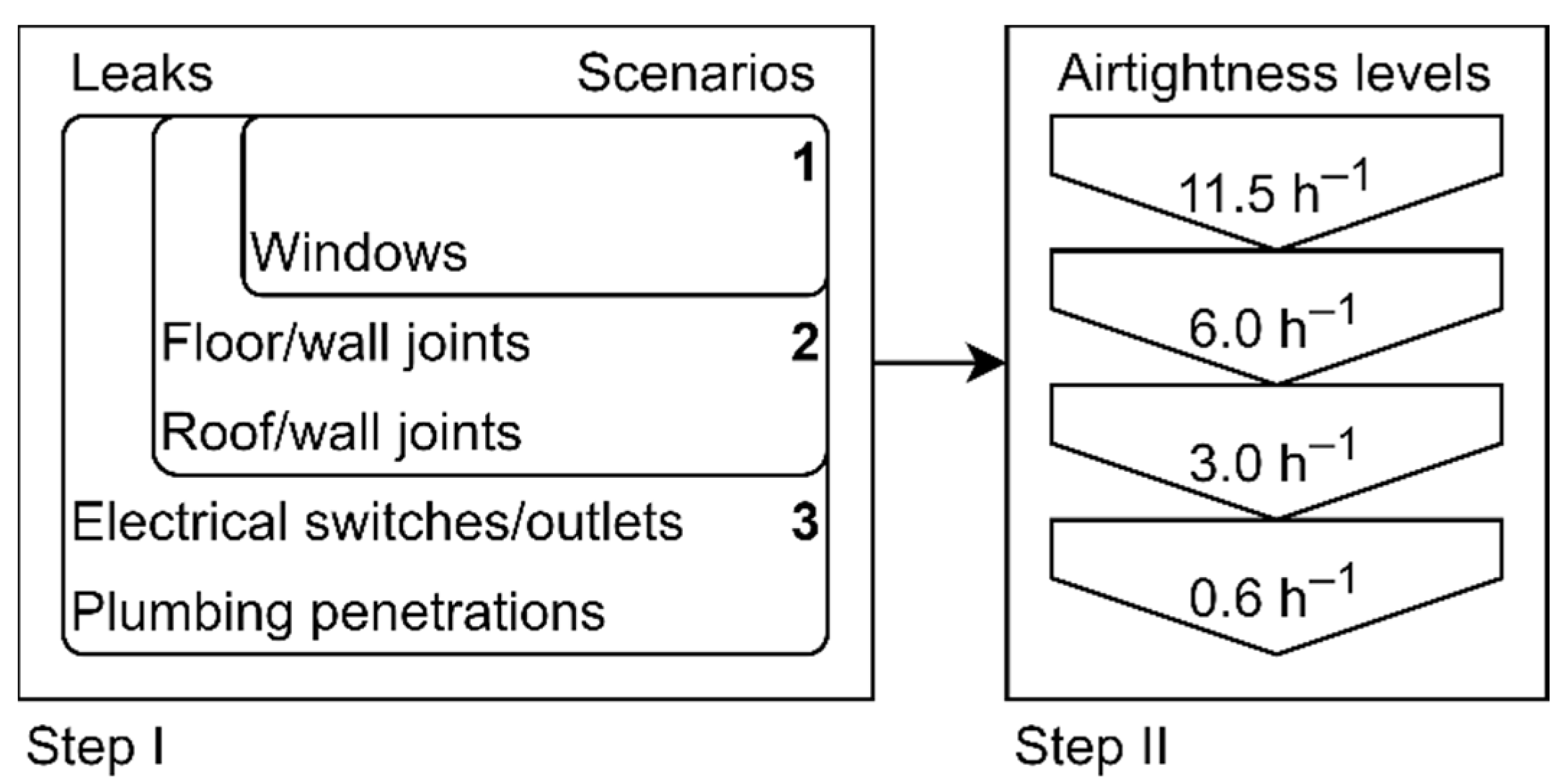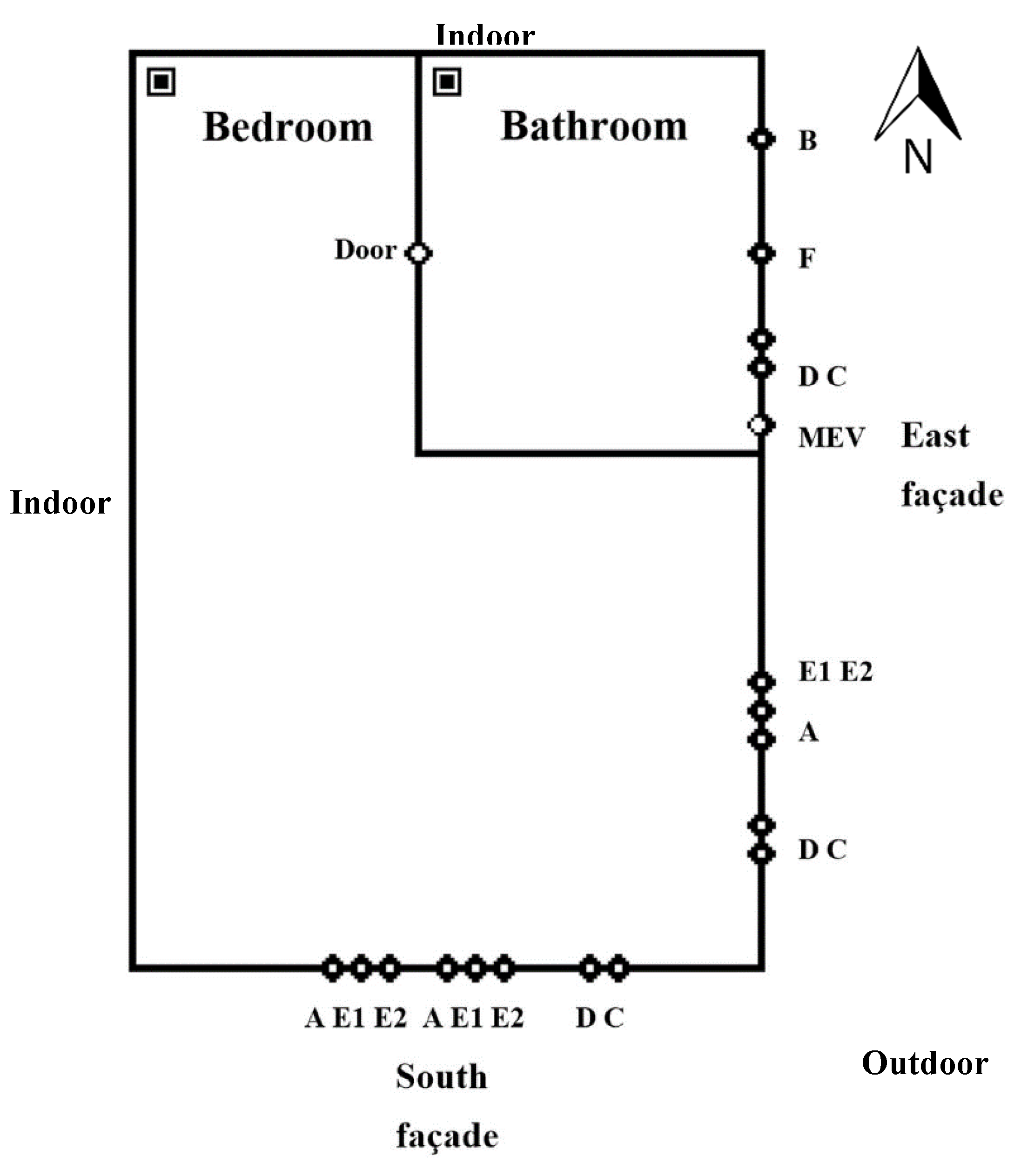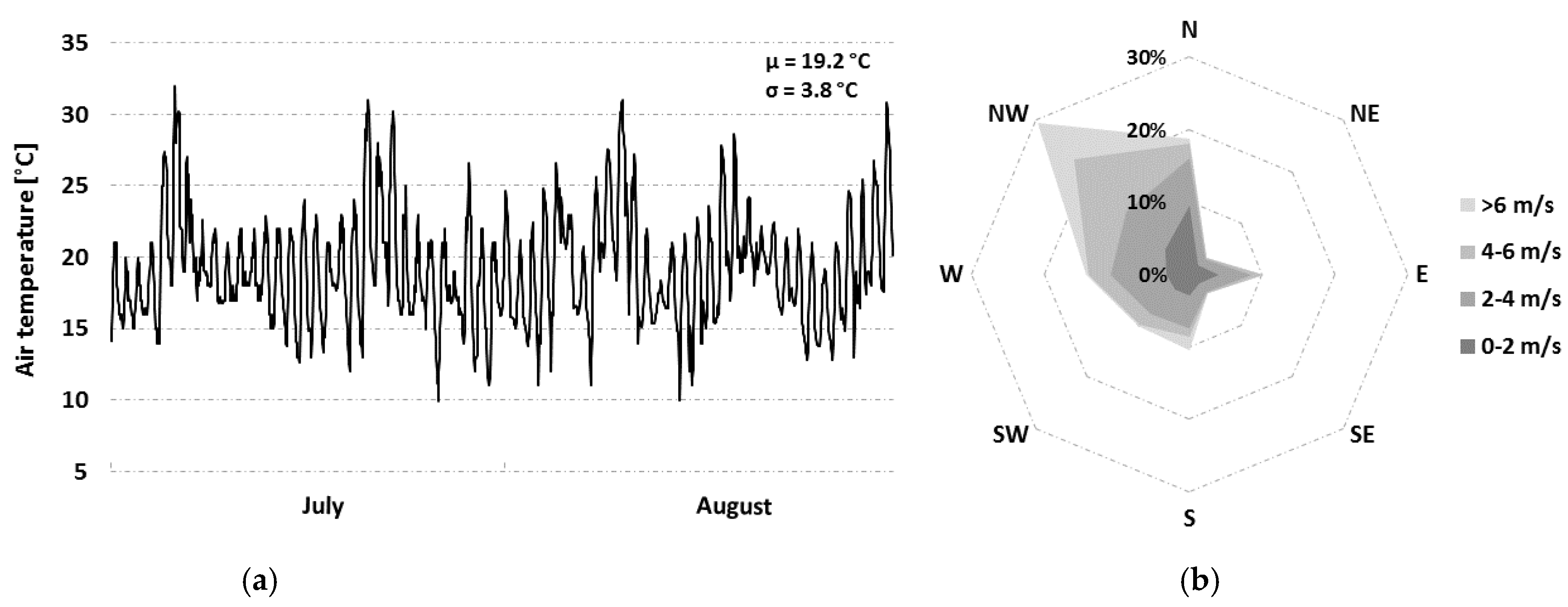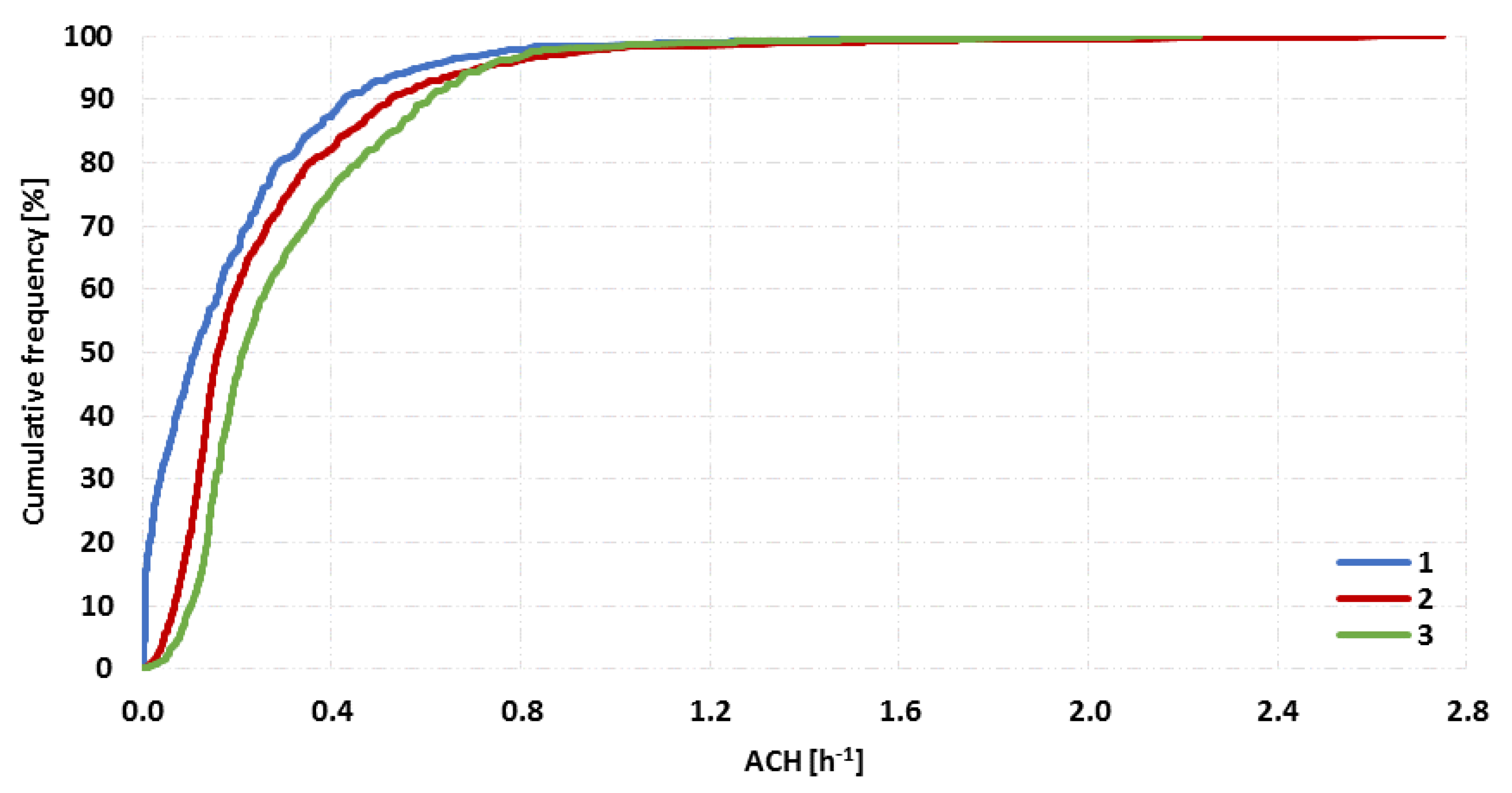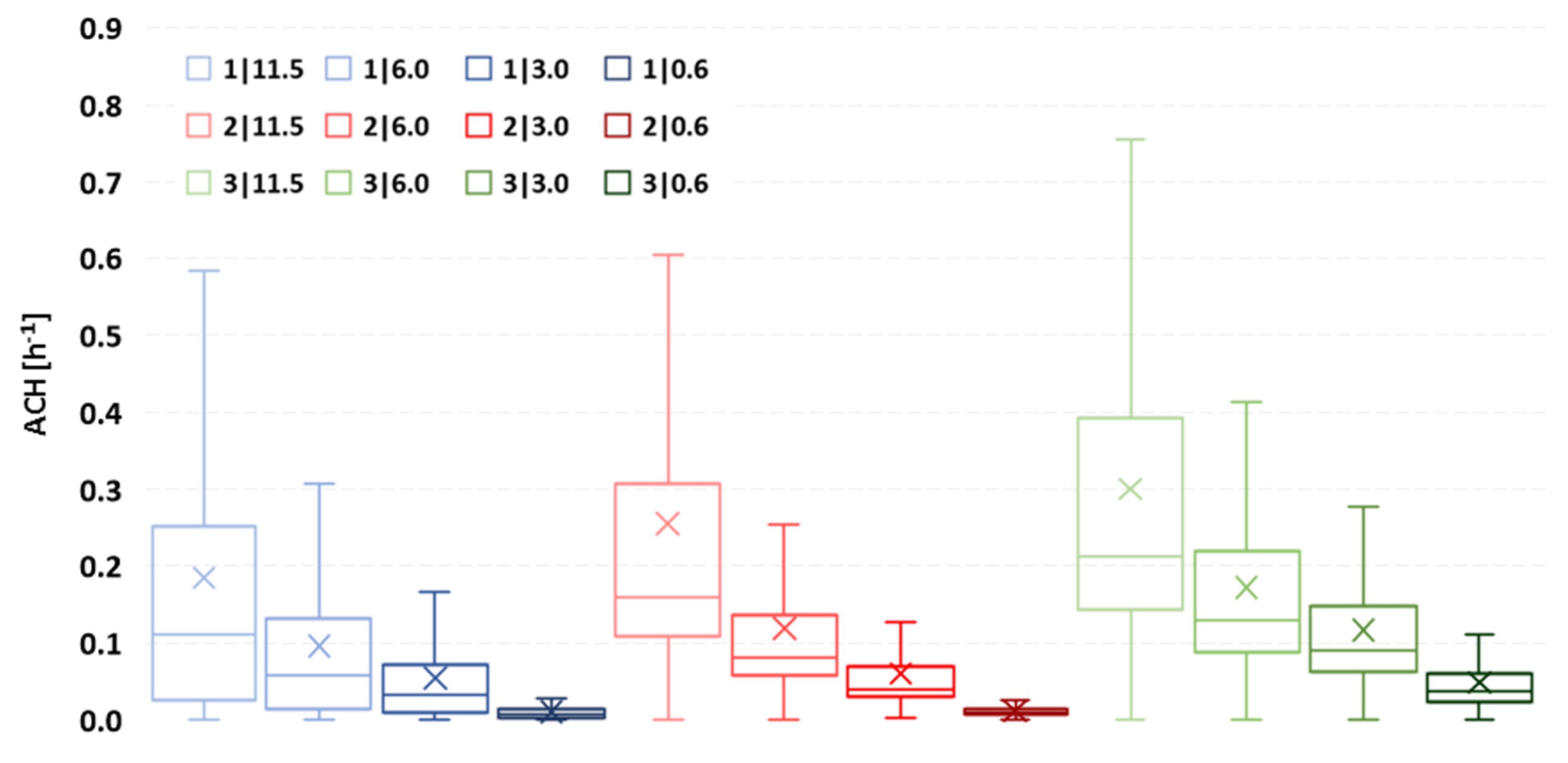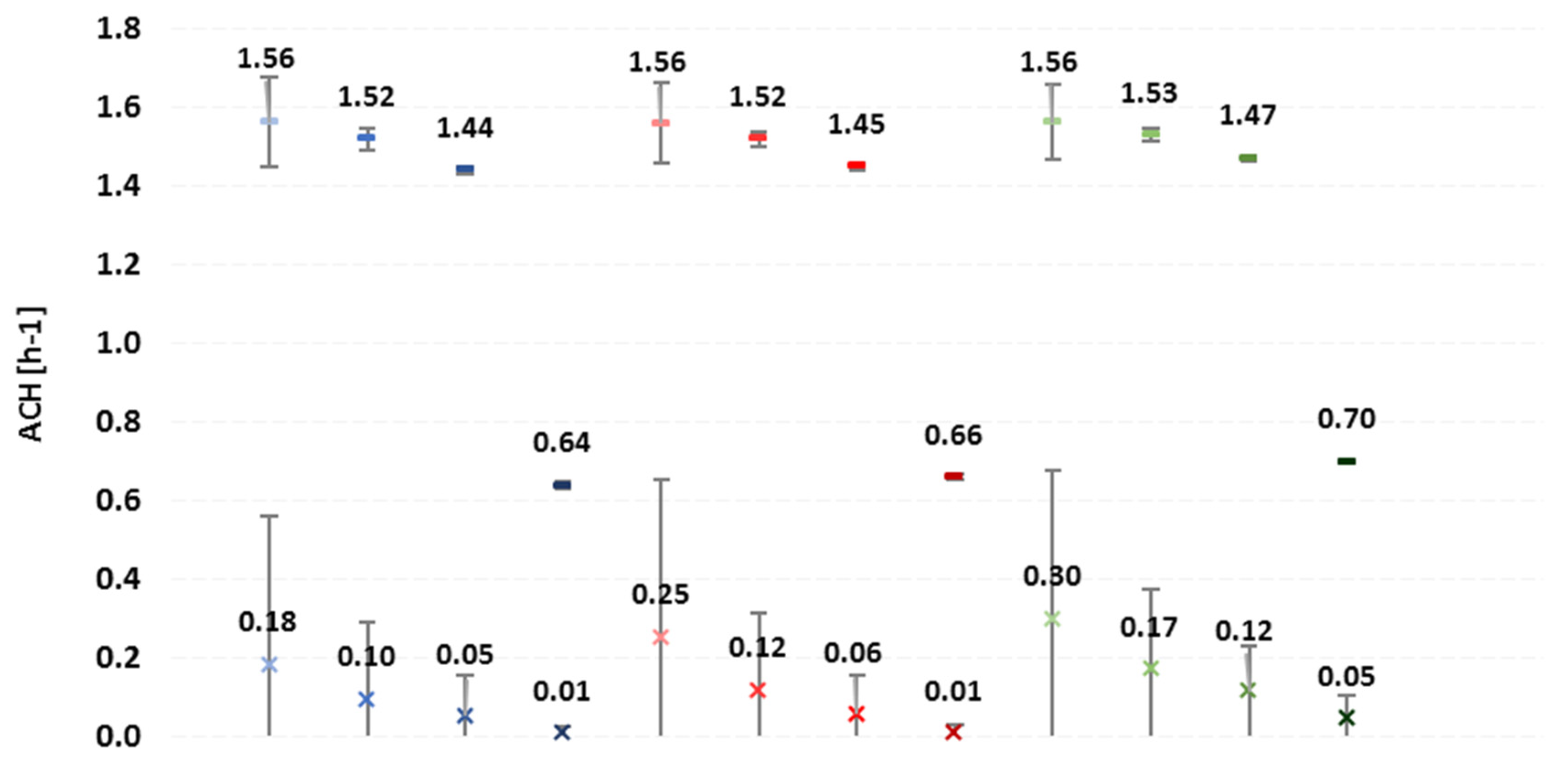3.1. Case Study, Measurements, and Equipment
The assessment of the ventilation performance of the case study took place in the months of July and August. The case study was an apartment in Porto, Portugal. The apartment has mechanical extraction ventilation (MEV) with air exhaust in the bathrooms and kitchen. The air supply takes place through unintentional air leakage paths. Two compartments of the case study (
Figure 1 and
Table 3) were monitored using nondispersive infrared (NDIR) sensors to measure the CO
2 concentration (
Table 4). During the measurement campaign, the door connecting the bedroom to the rest of the apartment remained shut when not in use.
The ACH value of the compartments was determined considering the concentration decay test method using the occupant-generated CO
2 as a tracer gas. The ACH value was determined for different ventilation configurations in standard conditions of use: with MEV on and MEV off. When MEV is on, it has a maximum extraction volume of 98 m
3/h. The CO
2 production estimation was calculated based on the methodology proposed by Coley and Beisteiner [
31]. The average night production of CO
2 was 5.97 cm
3/s. The value used for the external CO
2 concentration was the one indicated in ASTM-D6245 [
48], 350 ppm. An on-site outdoor CO
2 monitoring campaign validated this value for two weeks, with an average value of 348 ppm. The ACH values were calculated daily during the two months, taking into account the recommendation stated in the standard ASTM-E741 [
27].
According to Bekö et al. [
49], this technique estimates the total airflow into the studied room (total air exchange rate), including airflows from adjacent ones, and not only the outdoor air exchange rate. The same authors [
50] found that these errors average 30%.
Blower-door measurements were made to determine the compartments ACH
50 with a Retrotec Model 1000 fan [
51], coupled with a DM-2 gauge [
52]. The accuracies of the equipment are ±3% of the reading, and ±1% or 0.15 Pa (whichever is greater), respectively.
The ACH
50 of the compartments was determined by applying the method A of the standard EN 13829 [
53]. Both depressurization and pressurization tests were undertaken to a pressure difference of 50 Pa. The final ACH
50 is the average of those individual results.
3.2. Simulation Scenarios
An in-depth analysis of the case study was performed using numerical simulation. The selection of the software considered the following points, according to the recommendations stated by Orme and Leksmono [
36]:
The application of multizone modeling, since two zones were modelled—the bedroom and the adjacent bathroom;
The input of structured data related to climate and weather, such as long-term meteorological data files [
54], air leakage characteristics, from component airtightness databases [
55], and wind pressure coefficients, in the form of fully developed profiles [
56];
The modelling of air handling systems, since mechanical ventilation is present in the bathroom.
The CONTAM software [
57] was chosen, since it fulfils all these conditions. It is often used for the modelling of ventilation strategies and energy impacts [
58] and contaminant dispersion [
59]. This software also enables importing data from several sources, easing the creation and comparison of scenarios.
Figure 2 presents a plan on the ones considered.
In order to assess the impact of air leakage distribution on the ACH, three scenarios were modeled, all of them assuming the same airtightness level. The scenarios vary in the number of types of air leakage paths and assume that MEV is off. In Scenario 1, only the windows are considered. Scenario 2 encompasses windows, and joints of floor/wall and roof/wall. Lastly, Scenario 3 encompasses all of the air leakage path types of Scenario 2, plus electrical switches and outlets, and plumbing penetrations. The focus on the construction of these scenarios is the progressive shifting from a concentrated infiltration to a more disperse one.
Changing the ACH
50, and therefore altering the total effective leakage area (ELA), enables evaluating the impact on the ACH, both with and without mechanical extraction (MEV). For that, using the three modeled scenarios to assess changing air leakage paths configurations, four levels of ACH
50 were assumed for modeling, each resulting from a different source based on: the blower-door measurement, 11.5 h
−1; a mid-range requirement for dwellings with natural ventilation, 6.0 h
−1; a mid-range requirement for dwellings with mechanical extraction ventilation [
16], 3.0 h
−1; the passive house requirement on airtightness [
60], 0.6 h
−1.
The intention of using a case study and measurements was to have results on the performance of a real setup and to use those results as input data for a simulation. Simulating with this input data allows for the comparison with measurements results, supporting a partial validation of the assumed discretization and additional trust in simulation results for the other equated scenarios.
3.3. Input Data and Methodology
As most of the leakage paths are located randomly, in a real case, it is an almost impossible task to address each leakage path individually and identify its respective characteristics. Construction quality, manufacturing, and installation processes influence the characteristics of leakage paths [
61]. For that reason, when dealing with these input data, commonly, extensive libraries of effective leakage areas (ELAs) on typified air leakage paths are used, such as the ones present in ASHRAE [
62] and AIVC [
45].
In this particular work, as individual leakage characteristics are not known, a total ELA was calculated. An ELA is the area of a circular sharped edge orifice that would leak the same volume of air as a particular tested specimen when pressurized to a reference pressure difference [
63]. In other words, it represents an overall quantitative effect of the airflow paths. The three scenarios [
62] that are being analyzed assume the measured airflow of 50 Pa for both compartments. The total ELA is thus calculated from that airflow volume (Equation (3)), and, as such, it is the same for the three scenarios [
62]. The discharge coefficient for this case study was assumed as 1.0, typical of small openings.
where:
ELAr—equivalent or effective air leakage area at a reference pressure difference (cm2);
Qr—predicted airflow rate at Δpr (m3/s);
ρ—air density (kg/m3);
Δpr—reference pressure difference (Pa);
CD—discharge coefficient (-).
In order to apply a relative weight to the contribution of each type of leak to the overall performance, the libraries available on the website of National Institute of Standards and Technology (NIST) were used to quantify the airflow value of the elements [
55]. As all the values suggested in those libraries are based on a pressure difference of 4 Pa, the calculated total ELA needs to be converted (4). The values are also based in a discharge coefficient of 1.0 and an airflow exponent of 0.65.
where:
Ar,i—air leakage area at reference pressure difference Δpr,i (cm2);
CD,i—discharge coefficient used to calculate Ar,i (-);
n—pressure exponent (-).
The ELAs in these libraries are normalized by an interface metric (usually area, length, or item), meaning that only by multiplying it, does one get the entire ELA of a specific air leakage path (
) (5).
Table 5 presents the types of air leakage paths used in the simulation of the three scenarios and their respective normalized ELAs. In order to maintain the proportionality, and henceforth, the airtightness level to be the same in all scenarios, the transformation shown in (Equation (6)) must be made.
where:
ELAr,i —effective leakage area at a reference pressure difference of type i air leakage path (cm2);
ELAr,n—effective leakage area at a reference pressure difference normalized by an interface (cm2/metric);
I—interface metric of a type of air leakage path (usually m2, m, item);
ELAr,p,i—proportional effective leakage area at a reference pressure difference of type i air leakage path (cm2);
ELAr,total—effective leakage area at a reference pressure difference based on measurement results (cm2)
The ELA of a particular type of air leakage path (ELA
r,p,i) varies between scenarios, as the increasing consideration of additional types of leakage changes the relative contribution of each ELA (
Table 6). Air leakage interface metric indicates the extension of the leakage, linear meters (m) or the number of items, and envelope orientation is either south or east.
Figure 3 illustrates the model of the scenario with the highest number of types of air leakage paths (scenario 3). The mechanical extractor (MEV) in the bathroom is also included.
The door connecting the two compartments has a cross-sectional area of 1.4 m
2 and is considered open in the simulations. For all the other openings, since they are assumed as small, the discharge coefficient and the flow exponent assume the values defined in the ASHRAE libraries [
55].
The simulation period followed the same time period of the measurement campaign, July–August. Hourly averaged air temperature as well as wind speed and direction were obtained by the spatial interpolation of public weather data [
54] (
Figure 4). The wind pressure coefficients were estimated using the methodology proposed by Swami and Chandra [
56]. The performance data of the extraction fan of the bathroom were provided by the manufacturer.
The uncertainty on measurement results and the discretization for simulation, such as in weather data, wind pressure coefficients, and air leakage characteristics, is not insignificant. Still, since the considered scenarios have fairly disparate boundaries, the comparison of results between them will not be hindered by these factors. Therefore, best estimates of measurement results were considered, and coherently, best estimate values of the considered library on effective leakage areas were also admitted.
